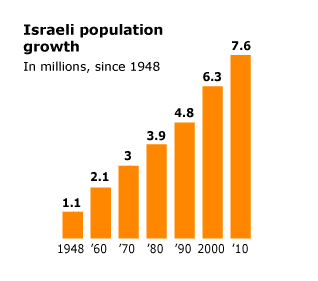
Political developments within Israel played a significant role in the progress of the negotiations between Israelis and Palestinians. From the foundation of the State of Israel, the Labour Party (formerly Mapai) had been the leading political formation, which formed coalition after coalition with one or several, mostly religious-oriented parties. The Labour Party’s prominent position lasted without interruption for almost thirty years. In the elections of June 1977, however, the Likud Party took over from Labour and formed a right-wing government under Prime Minister Menachem Begin. This cabinet also needed the support of religious parties. In Israel, this change almost felt like ‘a revolution’. In the next 23 years, until 2010, right-wing governments prevailed for fifteen years, Labour-led coalitions for eight years.

Since 1948, the Israeli population has grown from 1.1 million to 2.1 million (1960), 3.0 million (1970), 3.9 million (1980), 4.8 million (1990), 6.3 million (2000) to 7.6 million (May 2010). This growth was only partly natural. Most of the growth was due to immigration. Between 1990 and 2000, for example, no less than 900,000 migrants came to Israel from the former Soviet Republics. In 2008, the number of Israeli Arabs was 1.4 million (from 1.1 million in 2000).
Despite sometimes violent resistance by extremists on both sides against the Oslo Accords, Israel completed the withdrawal of its armed forces from the town of Jericho and parts of the Gaza Strip in May 1994 under a Labour Government led by Yitzhak Rabin. On July 1, Yasser Arafat entered Gaza; four days later he was in Jericho in the West Bank, where the Palestinian National Authority (PNA), the governing body, was sworn in. The PNA would gradually gain control over six large towns on the West Bank (Jenin, Nablus, Tulkarm, Ramallah, Qalqiliya, and Bethlehem) and over parts of Hebron, while Israel would redeploy from some 400 villages in the course of time. It was reaffirmed that the so-called permanent status negotiations were to be concluded by 1999.
But amidst all these optimistic signs, on 4 November 1995, Israel was shocked by the assassination of Prime Minister Yitzhak Rabin by an extremist right-wing Jewish youth, Yigal Amir, after attending a mass demonstration in Tel Aviv in support of the Oslo Process. Rabin’s successor Shimon Peres promised to continue the Israeli redeployment on the West Bank. In hindsight, however, it has to be concluded that the process has since stalled.

